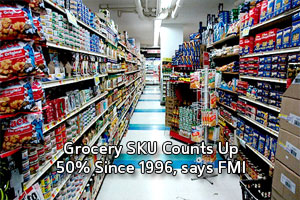Whether they will last or not is the question. Despite the supply chain costs of the larger number of SKUs in terms of forecast accuracy, inventory levels, material handling and more, generally new products and SKU-extensions are the result of the “innovation” often emphasized by company leaders and industry experts. SKU proliferation, in some cases, was also viewed as a way for manufacturers to expand or maintain shelf space and keep smaller competitors out.
 The 1990s especially was a time when views about “micro-marketing” encouraged manufacturers to more finely tailor products to smaller and smaller niches of buyers. Some cola drinkers want caffeine and some don’t. Ditto with diet or regular, and lime or no lime. Produce all the possible combinations, and each drinker can get what they want, but at a huge cost in SKU counts and supply chain complexity. The 1990s especially was a time when views about “micro-marketing” encouraged manufacturers to more finely tailor products to smaller and smaller niches of buyers. Some cola drinkers want caffeine and some don’t. Ditto with diet or regular, and lime or no lime. Produce all the possible combinations, and each drinker can get what they want, but at a huge cost in SKU counts and supply chain complexity.
That thinking is starting to change.
"All that go-go 1990s where we were adding items in and adding items in, and people wanted more, more, more, more choice... just didn't pay off," Catherine Lindner, Walgreen's divisional vice president for marketing development, said at a recent conference. She says consumers are confused. "People say, 'Whoa, you're bombarding me. Help me figure out what I need,'" Linder added.
Clearly, SKU reduction will reduce cost-adding complexity and drive higher profits.
“We generally end up with share and sales growth, and it's all, of course, a lot more profitable and returns a lot more cash," said retiring Procter & Gamble Chief Executive A.G. Lafley at an investor conference last month.
That’s great if you are P&G or the clear leader in a product category. But if you aren’t number 1 or 2, the change could mean you lose the retailer as a sales channel.
The Wall Street Journal, for example, reports Campbell Soup expects to gain about 10% to 15% more shelf space at large retailers this fall as a result of these SKU changes. P&G’s Lafley said SKU and vendor reduction “benefits the leaders in the industry and it disproportionately benefits P&G."
Another factor is the growth in private label brands. As more retailers put emphasis there, and consumers pinched by the recession respond to the lower price points, it creates more incentive to weed out some name brand products.
Whether the move will survive the eventual economic recovery or consumer preference of course remains to be seen. While many have been calling for a reduction in SKU proliferation, what manufacturers and retailers it really benefits and hurts in the end will be the key question.
What’s your take on the retailer SKU count reduction plans – a good or bad thing, and for whom? Do you think it will stick? How much does SKU complexity really cost manufacturers and retailers? Let us know your thoughts at the Feedback button below.
SCDigest is Twittering!
Follow us now at https://twitter.com/scdigest |